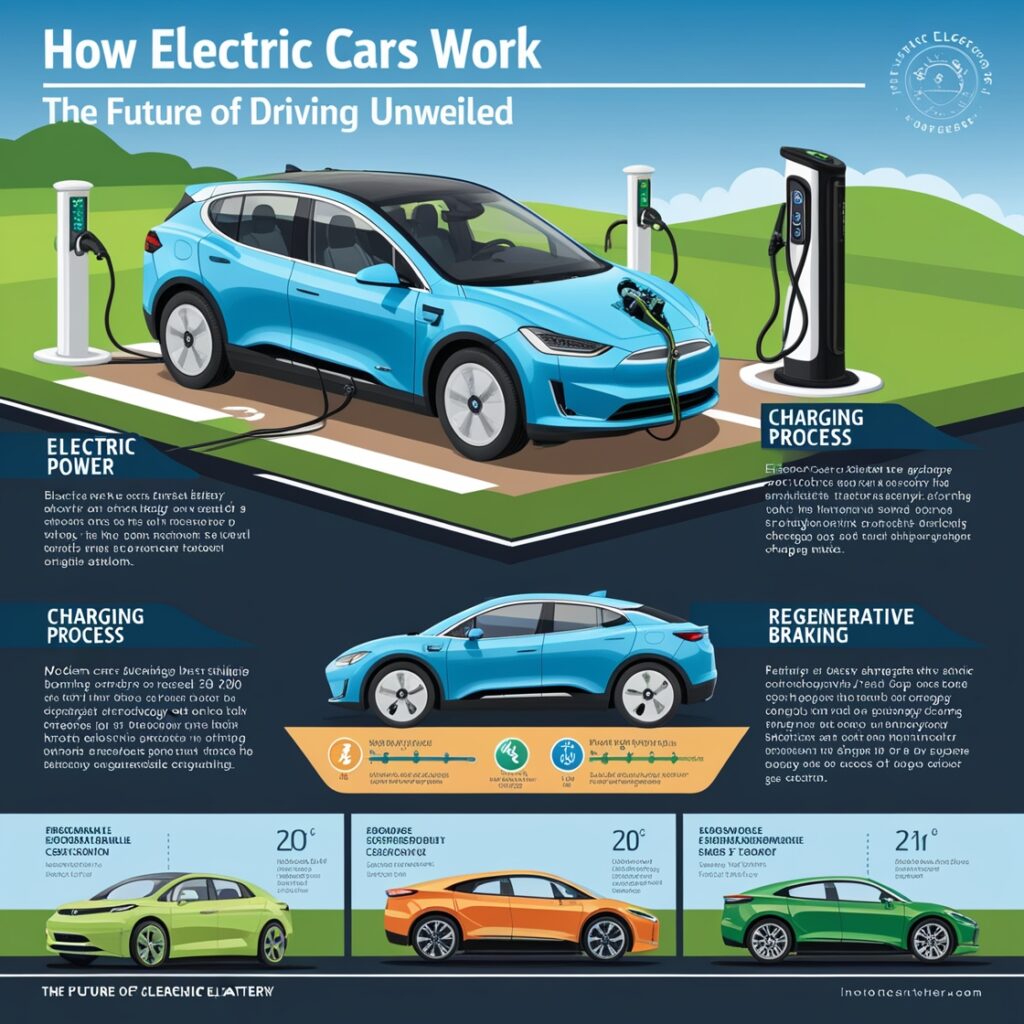Introduction: The Death of the Gasoline Engine
The world is changing. The roar of the internal combustion engine is slowly fading into the near-silent hum of electric motors. What once was supposed to be an eternal king on the roads – the gas-guzzling, fume-spewing gasoline car – has a new revolution up its sleeve.
Electric cars are no longer an exception but a rule. How electric cars work? What’s so great about them? And why should you, the clever and visionary driver, change to them? This detailed guide will let the cat out of the box regarding electric vehicles, showing their secrets: what lies behind the technology and the benefits, and why an electric car should be your next car.

Chapter 1: Heart of an Electric Car – Battery
The powerhouse of any electrical car is basically the battery thereof. Unlike the other automobiles powered by combustion engines and running on petrol or diesel, EV contains high-capacity lithium-ion batteries that store and supply electricity.
How electric cars Work:
Think of your smartphone: it works on a lithium-ion battery, which you regularly recharge. An electric car does the same thing, only on steroids. These batteries consist of hundreds or even thousands of single cells, working in concert for efficient storage and delivery of power.
Why Lithium-Ion?
Lithium-ion batteries are favored because of three main reasons:
1. High Energy Density – They store more energy in less space.
- Longer Life – They can support thousands of charge cycles.
- Quick Charging – Technology for fast charging is getting better with each passing year.
And the icing on the cake? Unlike petroleum, which burns and disappears, electricity can be generated through renewable sources. The sun, wind, and water can power your vehicle—oil dependence now will be a thing of the past.
Chapter 2: The Electric Motor – The Powerhouse of Efficiency
Compared with a conventional automobile, in which power is generated by a controlled explosion of fuel, it is inefficient, noisy, and thoroughly wasteful, an electric automobile derives power directly from an electric motor. It’s simple, elegant, and nearly lossless.
Magic of Electric Motors:
Electric motors have an astonishing efficiency of conversion of electrical energy into mechanical energy, often above 90%. That means almost all the energy stored in the battery gets used to move the car forward. In contrast, a gasoline engine converts only about 30% of its fuel into usable power; the rest is wasted as heat and noise.
Instant Torque – The Electric Advantage:
Ever wondered why Teslas accelerate like rockets? Unlike gas engines, which require time to build up power, electric motors deliver instant torque. Step on the accelerator, and you’re propelled forward with breathtaking speed.
Chapter 3: Regenerative Braking – Stopping to Go Further
Now, just think that each time you apply the brakes in a gasoline car, you fill up the tank instead of wasting the energy. That is just what regenerative braking performs in an EV.
How electric cars Work:
- Strike the brake pedal, and the electric motor of the car turns into reverse mode.
- Instead of traditional brakes engaging to slow the vehicle down, the motor now acts like a generator.
- It converts kinetic energy back into electricity, which is stored in the battery for later use.
More range, less wear on your brakes, and an incredibly efficient drive are the results.
Chapter 4: Charging – The New Way to Refuel
Refueling a gas car takes five minutes, while charging an EV takes longer. But here’s the truth: you don’t need to refuel an electric car like a gas car.
Home Charging: Plug in at home, just like your phone. Then, in the morning, it’s full and ready to go.
Public Charging: Charging stations are everywhere, and they’re getting faster. With rapid chargers, you can get 80% charge in 30 minutes—enough for most road trips.
The Cost Advantage:
Charging is far less expensive than gasoline. Where you live may matter, but for many people, it could be less than a cup of coffee per day to charge their car.
Chapter 5: The Environmental and Economic Edge
An electric car isn’t just smart-it’s the responsible choice. Learn how electric cars work
Zero Emissions:
A gasoline car spews pollution every time you drive. An EV? Zero tailpipe emissions. Cleaner air, a healthier planet.
Lower Running Costs:
Electric cars have fewer moving parts. No oil changes, no exhaust systems, no complex transmissions. The result? Lower maintenance costs and fewer trips to the mechanic.
Government Incentives:
Many countries offer tax credits, rebates, and incentives for EV buyers. Switching to an electric vehicle isn’t just eco-friendly—it’s wallet-friendly too.
Chapter 6: The Future of Electric Cars
What’s next? The EV industry is evolving at breakneck speed.
Longer Ranges:
New battery technologies promise 500+ miles on a single charge. Range anxiety will soon be a thing of the past.
Faster Charging:
Solid-state batteries could reduce charging times to just 10 minutes. Imagine grabbing a coffee while your car fully charges.
Autonomous Driving:
How electric cars work? and self-driving technology go hand in hand. Tesla, Rivian, and other brands are pushing the boundaries of AI-driven mobility.
Conclusion: Why You Should Switch Now
You do have a choice: either to continue with some outdated, polluting gasoline engine cars or up the ante with an electric car.
With superior efficiency, lower costs, and a cleaner planet, there is no better time to make that switch. The revolution has begun, and smart drivers are already leading the trend.
So ask yourself: Are you driving the past, or are you driving the future?